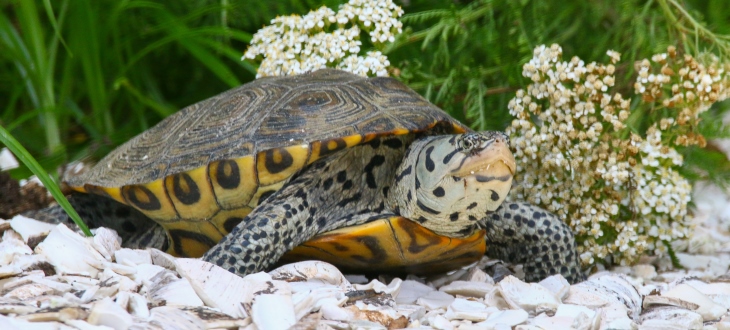The State We're In
Diamondback terrapins, our salt marsh turtles
Why did the turtle cross the road?
On a mid-July day, a diamondback terrapin tried to cross busy 2nd Avenue in downtown Stone Harbor, in Cape May County. How it got there and where it was going are mysteries. The turtle was not near any water! One thing was certain: It was in immediate danger of being run over.
Luckily, a passer-by scooped up the turtle and delivered it to the Wetlands Institute, a Stone Harbor-based nonprofit dedicated to protecting New Jersey’s coastal salt marshes and their inhabitants.
Lo and behold, the turtle had a micro-chip – a tiny radio transponder – under its skin. The radio “tag” revealed an amazing story: the diamondback terrapin was hatched in 1999 right at the Wetlands Institute, from an egg harvested from a female turtle killed by a car.
“The tag showed that she had been released 19 years earlier” at one year of age, said Wetlands Institute spokesman Devin Griffiths. “And she hadn’t been seen that entire time.”
Helping diamondback terrapins – and understanding their life cycles and movements – is a special project of the Wetlands Institute, which is celebrating its 50th anniversary this year.
Diamondback terrapins are the only turtles in the world that spend their entire lives in brackish coastal marshes, where freshwater and saltwater mix.
Northern diamondbacks terrapins – the subspecies found in New Jersey – range from Cape Hatteras, N.C., to Cape Cod, Mass. “Across their entire range, they’re in decline,” noted Griffiths. In New Jersey, they’re listed as a “species of special concern,” which means they need help.
Terrapins were once very common and provided food for Native Americans and European settlers. From the mid-1800s through the early 1900s, they were nearly hunted to extinction.
Populations partially rebounded in the past century. Although terrapins are no longer hunted in New Jersey, they still face many threats, including habitat destruction, crab traps, poaching and cars.
Cars are probably the most serious danger. Female terrapins leave the salt marshes each spring to lay their eggs on higher ground and often cross busy roads.
Each spring, the Wetlands Institute sends out “turtle patrols” in specially marked vehicles on roads through the salt marshes. More than 750 turtles were rescued this year by staff members, volunteers and interns. The Wetlands Institute also fences off “hot spots” along busy roads to stop the turtles from crossing.
But turtle patrols can’t be everywhere, and hundreds of female terrapins are hit during the breeding season. When a turtle is injured, the Wetlands Institute tries to save her. If the turtle is killed, the Institute removes any undamaged eggs and places them in an incubator to hatch.
This year, the Wetlands Institute recovered 884 eggs from female terrapins killed on the road. So far, over 260 baby turtles have hatched, and more are expected to hatch in the next month.
This summer’s hatchlings will enter a “head start” program in the fall. Stockton University and many local schools adopt hatchlings and care for them during the school year.
Unlike terrapins in the wild, head-started hatchlings don’t hibernate. Instead, they’re fed a rich diet all winter to build up their strength. By spring, they will be three to four times the size of wild terrapins their age. The Institute believes this gives them a survival advantage when released.
All head-started terrapins are outfitted with micro-chips before being released, allowing them to be identified if found in the future.
The Institute recently started another tracking program to learn more. Larger radio tags were attached to the shells of about 30 turtles to monitor their movements in the salt marshes. Solar-powered receivers listen for “pings” from the tagged terrapins and collect data.
“The goal is to try to paint as complete a picture as we can,” said Griffiths. “The more we know about them, the better we can conserve them.”
If you’re driving around the salt marshes of southern New Jersey, be sure to keep an eye out for terrapins! And if you’re in Stone Harbor, drop by the Watershed Institute to check out its educational exhibits and take a stroll on the elevated walkway over a beautiful salt marsh.
To learn more about diamondback terrapin conservation programs, visit the Wetlands Institute website at https://wetlandsinstitute.org/conservation/terrapin-conservation/.
And more information about preserving New Jersey’s land and natural resources, visit the New Jersey Conservation Foundation website at www.njconservation.org or contact me at info@njconservation.org.
About the Authors
Alison Mitchell
Co-Executive Director
John S. Watson, Jr.
Co-Executive Director
Tom Gilbert
Co-Executive Director, 2022-2023
Michele S. Byers
Executive Director, 1999-2021
View their full bios here.
Filter
Get The Latest News
From The Garden State
In the
News

